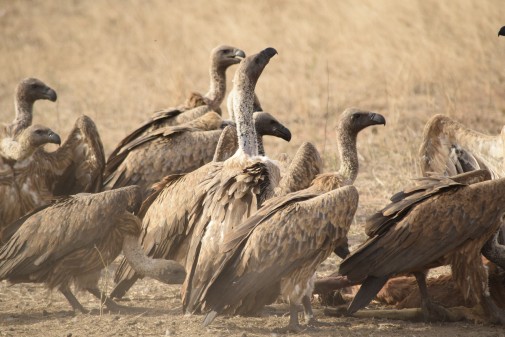Study shows vultures have an appetite for long-distance travel
Posted on 3 October 2022
 Scientists used tracking data from 26 individual vultures. Pic credit: Natasha Peters
Scientists used tracking data from 26 individual vultures. Pic credit: Natasha Peters
These epic journeys were observed by scientists using specialised GPS tags to track the movements of African white-backed vultures in Tanzania.
One bird was tracked visiting eight countries as part of a “grand tour” of southern Africa, taking in Tanzania, Zambia, Zimbabwe, Botswana, Mozambique, Democratic Republic of the Congo, South Africa and Namibia.
Poison
The research team used tracking data from 26 individual vultures tagged at five locations across southern Tanzania to identify their behaviour patterns.
Lead author Natasha Peters, a PhD student in the University of York’s Department of Biology, said: “We knew vultures travelled big distances but this is the first time we have identified the specific areas they use when they forage and feed, behaviours that can put them at risk for encountering poison.
“We can use the data to inform effective conservation interventions - assessing when and where the vultures are at greatest risk from harm.”
Conservation
Dr Corinne Kendall, from North Carolina Zoo, which led the vulture research and conservation efforts in southern Tanzania, said: “Vultures are currently one of the fastest declining bird groups due to poisoning, which occurs when people lace carcasses with pesticides.
“Understanding their habitat use, and even more importantly their behaviour while in certain habitats, like outside of protected areas, is thus critical for their conservation. ”
The study revealed that although vultures spend most of their time in protected areas (64.2%) and stationary (75.5%), when foraging they prefer to use areas outside National Parks, specifically in Game Reserves and Wildlife Management Areas.
Interestingly, vultures avoided areas with high livestock density when feeding, suggesting that they don’t use cattle as a main food source and avoid areas with high human habitation.
The average distance travelled per month in the dry season was just over 3,000km, dropping to 2,251km in the wet season, the data revealed.
Breeding
Dr Colin Beale, from the University of York’s Department of Biology and academic supervisor for the study, added: "One of the most remarkable findings from this study is that while many birds undertake occasional long-distance journeys, they are much more local when breeding and maintain separate breeding populations more isolated from one another than we expected."
Previous studies have shown that vultures are highly susceptible to poisoning because of their communal feeding which results in large-scale mortalities at a single poisoning event.
One way of protecting the birds is to map foraging and feeding areas and identify key locations where greater conservation action may be needed.
Wildlife Conservation Society Ruaha-Katavi Landscape Director, Aaron Nicholas, added: “While these findings provide a fascinating insight into the vast distances covered by vultures in their daily lives, it also reminds us of the interconnected nature of distant habitats and the need to think and plan at scale when developing conservation actions for vultures, and other species.”
Further information:
Explore more news

Climate change set to take over as key driver of biodiversity loss by 2050, experts warn
Thursday 25 April 2024

Conservation actions are effective at halting and reversing biodiversity loss, study reveals
Thursday 25 April 2024

More than a quarter of people with Covid infection develop Long Covid, new research reveals
Thursday 25 April 2024
.jpg)
University of York awarded £1.1 million to lead the first stage of UK’s first comprehensive study on devolution and social security
Thursday 25 April 2024

More hybrid and nature-based solutions are urgently need to protect coastal communities from climate change
Wednesday 24 April 2024
Media enquiries
About this research
The research team, which included experts from North Carolina Zoo and the Wildlife Conservation Society, used tracking data from 26 individual vultures tagged at five locations across southern Tanzania to identify their behaviour patterns. The study is published in the Journal of Biogeography.
